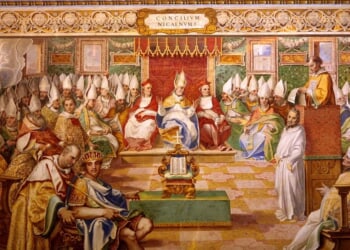All Poles recognize the likeness of Gary Cooper from the 1952 film High Noon. The Polish Cooper holds an election ballot over a backdrop of the Solidarity trade union’s iconic red letters. Below his feet appear the words “High Noon 4 June 1989.” The political poster appeared all over Poland that year, ahead of the first partially free elections of the communist Polish People’s Republic, and it became one of the most enduring symbols of the fall of communism in Europe.
Sikorski and Wałęsa count among the Polish liberals clinging to 1989, unwilling to accept that the worldview they have served has become discredited.
Last week, Polish Minister of Foreign Affairs and Deputy Prime Minister Radosław Sikorski presented a copy of the poster, signed by Solidarity leader and Nobel Peace Prize laureate Lech Wałęsa, to Secretary of State Marco Rubio in Miami. It should have been a banal gesture between politicians, but it will be remembered for its symbolism. Sikorski and Wałęsa count among the Polish liberals clinging to 1989, unwilling to accept that the worldview they have served has become discredited. (Ironically, this acceptance on the part of their communist predecessors is what permitted their ascent to power.) (RELATED: The Enduring Spirit of Solidarity: A Story Still Being Written)
To the casual observer, the meeting of foreign ministers might have seemed a logical prelude to the next day’s more notable meeting between President Donald Trump and newly elected Polish President Karol Nawrocki at the White House. The American hosts greeted Nawrocki with a flyover of military aircraft and a warm, choreographed reception. Nawrocki’s camp and a handful of opponents proclaimed this inaugural foreign visit a success, as President Trump confirmed the United States would not withdraw troops stationed in Poland, and indeed had never considered doing so, and personally invited Nawrocki to this November’s G20 summit in South Africa.
Buoyed by this success, President Nawrocki flew to Rome for meetings with Pope Leo XIV and Italian Prime Minister Giorgia Meloni. Sikorski, a leading figure in the current government coalition of liberals, leftists, and centrists (elected separately from the president), remained in the United States. The dueling visits of the Polish camps had been uncoordinated. Sikorski insisted his parallel visit was not meant to upstage Nawrocki’s, a claim that strains credulity.
With the president back in Europe and the minister lingering in the United States, the pre-visit barbs continued across the Atlantic. Sikorski maintained he was responsible for the G20 invitation. Nawrocki contended that he alone can assure cooperation with the United States, as relations between Washington and Warsaw have been strained since Trump’s reinauguration. Both camps issued their interpretations of who was representing Poland, and how.
Several days after the visits should have receded into diplomatic history, the saga took another bizarre turn when Sikorski posted a series of selfies in front of American government buildings in Washington. “It’s just a pathetic embarrassment,” summarized conservative journalist Stanisław Janecki.
“Dear Minister Radosław Sikorski, I am already in Poland … I am unable to look at your album from Washington in any other form, but I appeal for seriousness,” wrote the president on social media. “This is not a matter of your good — albeit disturbing — mood. These are matters of state. I believe that as soon as I find the time, and you cool down a little, we will meet for a serious conversation about the disturbing state of Polish diplomacy.” Sikorski retorted, “Your people informed on the Prime Minister and the democratic government of free Poland in Washington, trying to block its access to the White House.”
Sikorski’s apparent belief that he had a role at the White House illuminates his boundless ego. The minister has run in powerful circles for decades, and his public outbursts have included calling Trump a “proto-fascist” and inviting pro-Trump American populists to “f— off.”
In 2014, a diplomatic scandal ensued when a news magazine published a recording of Sikorski opining that “the Polish-U.S. alliance isn’t worth anything” and “we [Poles] gave the Americans a b— job.” Americans might recall that Sikorski is married to journalist Anne Applebaum, who produces regular bombast for the Atlantic and publishes books on authoritarianism every couple of years for an aging coastal audience. Sikorski’s chief, Prime Minister and former President of the European Council Donald Tusk, is another of the liberal old guard with no prospects in Washington. He has previously accused President Trump of serving Russia, and a 2019 photo of him pointing a finger-gun at the U.S. president’s back has hardly facilitated reconciliation.

This generation of Polish liberals assumed their worldview was a foregone conclusion in Poland and across the former Warsaw Pact. After watching its bitter rivals govern for eight years, the Tusk government has begun to flounder less than two years into its term, following Nawrocki’s victory in the presidential race this summer. Polls suggest its constituent parts would have no realistic path to forming a government if elections were held today. The government remains a patchwork coalition united only by contempt for the previous right-wing government. Restive agricultural voices cringe at radical social initiatives; restive leftists insist they are moving too slowly; and both are displeased with the European Union’s heavy hand in Polish markets.
Young Poles were supposed to experience the fruits of a wealthy society and become good liberals, but that theory has unraveled. Nawrocki triumphed in both the 18-to-29 and 30-to-44 age cohorts, stymying the liberal Warsaw mayor with impeccable open-society credentials. Urban university-educated women gravitate more naturally to the Left coalition, with its emphasis on abortion and rainbow manifestations, than to the liberals. Young men aren’t convinced their European inheritance is all they’ve been promised. (RELATED: What Next for Poland After Nawrocki Victory?)
Nor are the liberals’ key selling points particularly persuasive. Poland experienced unprecedented economic growth during populist-right governments from 2015-23. The two warring political camps are essentially indistinguishable on the topics of the war in Ukraine and the Russian threat. The current government is persona non grata in Washington, and its celebrity status in Brussels counts for less than it did before the damage of European liberal governance became so widely recognized. The narrative that the adults in the room should manage economic and foreign policy has lost its sting.
There is historical precedent for this political theater. During World War I, socialist Józef Piłsudski jockeyed with nationalist Roman Dmowski in Great-Power capitals to shape the future of an independent postwar Poland. During World War II, the Polish government-in-exile sought to preserve its legitimacy in the face of a Moscow puppet regime. In both cases, the nationalists lost.
Then, why look further than 1989? In that year’s partially free elections, non-communist parties were only permitted to contest 35 percent of parliamentary seats, in addition to all 100 in the Senate. Government strategists prepared for a scenario in which Solidarity would win few or no seats, but the upstart opposition secured all 161 contestable parliamentary seats and 99 of 100 in the Senate. By January 1990, the Polish United Workers’ Party had dissolved. “The postwar consensus trusted that a better future could be achieved by removing barriers, setting aside traditional mores, empowering individual choice, and letting markets decide,” writes American theologian R.R. Reno.
This bright liberal future has resulted in Lech Wałęsa — a devout Catholic who famously signed the 1980 Gdańsk Agreement with an oversized pen featuring Pope John Paul II — supporting a government pushing abortion expansion, transgenderism, and depraved sexual “health” lessons for students. The Nobel laureate, whose fall speaking tour is advertised in several American print publications, would do well to reflect on these lessons.
READ MORE from Michael O’Shea:
What Next for Poland After Nawrocki Victory?
Is Poland the Next Victim of Mass Migration?
Time to Ditch the Media and NGOs’ Freedom and Democracy Rankings
Michael O’Shea is an American-Polish writer and translator. He is a Danube Institute visiting international fellow.





![Gavin Newsom Threatens to 'Punch These Sons of B*thces in the Mouth' [WATCH]](https://www.right2024.com/wp-content/uploads/2025/08/Gavin-Newsom-Threatens-to-Punch-These-Sons-of-Bthces-in-350x250.jpg)
![ICE Arrests Illegal Alien Influencer During Her Livestream in Los Angeles: ‘You Bet We Did’ [WATCH]](https://www.right2024.com/wp-content/uploads/2025/08/ICE-Arrests-Illegal-Alien-Influencer-During-Her-Livestream-in-Los-350x250.jpg)
![Black BET Billionaire Donor Stuns Democrats, Gives $500K to Winsome Earle-Sears [WATCH]](https://www.right2024.com/wp-content/uploads/2025/08/Black-BET-Billionaire-Donor-Stuns-Democrats-Gives-500K-to-Winsome-350x250.jpg)






